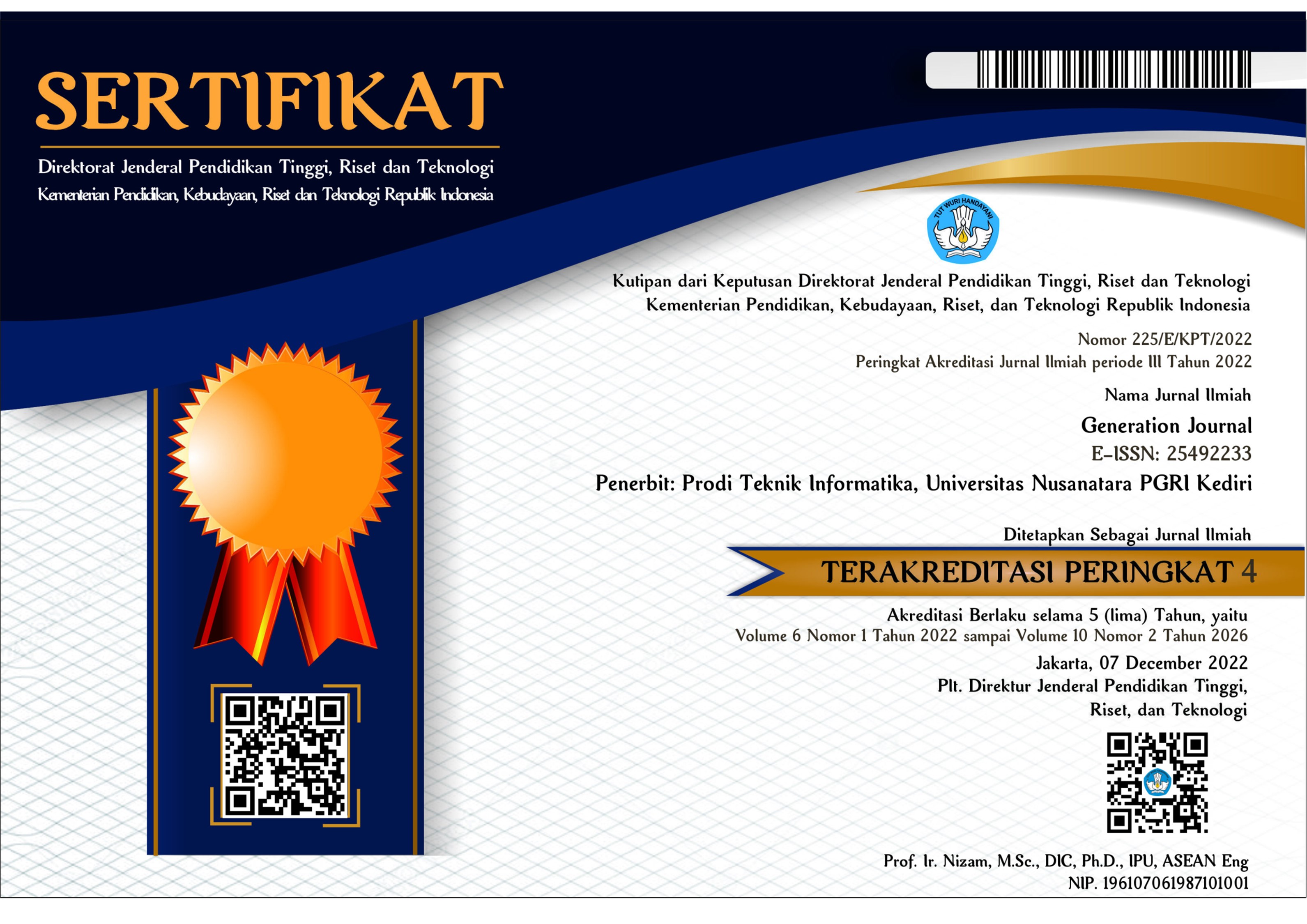Implementasi Algoritma C.45 dalam Klasifikasi Kondisi Ekonomi Warga Kabupaten Boyolali
(Studi Kasus Desa Sumbung Kecamatan Cepogo)
DOI:
https://doi.org/10.29407/gj.v8i2.22827Keywords:
C4.5 Algorithm, Data Mining, Decision Tree, Economic Conditions, MCD BoyolaliAbstract
The economic impact following the Covid-19 pandemic has been felt by various countries. The Indonesian government is implementing economic recovery and providing social assistance based on economic conditions, but there are still residents who do not receive assistance but deserve help. The Sumbung Village Government is trying to anticipate by looking for indicators that influence economic conditions.The research was carried out using the Data Mining classification method. uses the C4.5 Algorithm because it produces decision tree visualizations that are easy to understand. The data used is Boyolali MCD data for Sumbung Village, Cepogo District. As a result of the analysis of 21 attributes, 8 criteria with the highest weight for indicators of economic conditions. The accuracy reached 94.47%, higher than Naïve Bayes (93.28%) and K-NN (91.70%), making it suitable for classifying the economic conditions of Boyolali Regency residents, especially Sumbung Village.
References
Y. Puspitasari Gobel, “Pemulihan Ekonomi Indonesia Pasca Pandemi Covid-19 Dengan Mengkombinasikan Model Filantropi Islam Dan Ndeas Model,” J. Tabarru’ Islam. Bank. Financ., vol. 3, no. 2, hal. 209–223, 2020, doi: 10.25299/jtb.2020.vol3(2).5809.
W. Lidysari, H. S. Tambunan, dan H. Qurniawan, “Penerapan Data Mining Dalam Menentukan Kelayakan Penerima Bantuan Sosial Pemko Dengan Algoritma C4.5 (Kasus Kantor Kelurahan Martoba),” Kesatria J. Penerapan Sist. Inf. (Komputer dan Manajemen), vol. 3, no. 1, hal. 53–61, 2022, doi: 10.30645/kesatria.v3i1.97.
I. P. Ninditama, W. Cholil, M. Akbar, dan D. Antoni, “Klasifikasi Keluarga Sejahtera Study Kasus: Kecamatan Kota Palembang,” J. TEKNO KOMPAK, vol. 15, no. 2, hal. 37–49, 2020, doi: https://doi.org/10.33365/jtk.v15i2.1156.
F. Indahsari, D. Susanti, dan A. Supriyanto, “Implementasi Metode SAW-AHP Dalam Penentuan Prioritas Penerima Bantuan Sosial Kemiskinan Berdasarkan Kriteria BPS,” Jutisi J. Ilm. Tek. Inform. dan Sist. Inf., vol. 13, no. 1, hal. 234–246, 2024, doi: http://dx.doi.org/10.35889/jutisi.v13i1.1766.
S. Wahyuni, E. Hariyanto, dan S. Batubara, Data Mining dengan Decision Tree C4.5 dan Apriori (Konsep dan Implementasi Menggunakan RapidMiner dan Weka), Cetakan 1. Yogyakarta: Penerbit Deepublish (Group Penerbitan CV Budi Utama), 2022.
R. Maulana, A. J. Pitoyo, dan M. A. F. Alfana, “Analisis Pengaruh Kemiskinan dan Kondisi Ekonomi Terhadap Indeks Pembangunan Manusia di Provinsi Jawa Tengah Tahun 2013-2017,” Media Komun. Geogr., vol. 23, no. 1, hal. 12–24, 2022, doi: 10.23887/mkg.v23i1.39301.
Menteri Sosial Republik Indonesia, Keputusan Menteri Sosial Republik Indonesia Nomor 262/HUK/2022 Tentang Kriteria Fakir Miskin, no. 31.12.2022. 2022, hal. 1–3. [Daring]. Tersedia pada: https://dinsos.jogjaprov.go.id/wp-content/uploads/2023/03/KEPMEN-262-TAHUN-2022-Kriteria-Fakir-Miskin.pdf
A. Sitepu, “KARAKTERISTIK KELUARGA MENURUT PERINGKAT KEMISKINAN: STUDI PENDAHULUAN UNTUK PERUMUSAN KRITERIA FAKIR MISKIN,” Pus. Penelit. dan Pengemb. Kesejaht. Sos. Kementeri. Sos. Republik Indones., vol. 17, no. 01, hal. 49–63, 2012, doi: https://ejournal.kemensos.go.id/index.php/Sosioinforma/article/view/930/490.
M. F. Rizqullah, N. T. Raihana, dan M. I. Jambak, “Komparasi Penerapan Algoritma C4.5, K-Nearest Neighbor, dan Naïve Bayes untuk Keberlangsungan Pasien Gagal Jantung,” KLIK Kaji. Ilm. Inform. dan Komput., vol. 4, no. 5, hal. 2580–2587, 2024, doi: 10.30865/klik.v4i5.1788.
E. Fitriani, “Perbandingan Algoritma C4.5 Dan Naïve Bayes Untuk Menentukan Kelayakan Penerima Bantuan Program Keluarga Harapan,” Sistemasi, vol. 9, no. 1, hal. 103, 2020, doi: 10.32520/stmsi.v9i1.596.
A. Supriyadi, “Perbandingan Algoritma Naive Bayes dan Decision Tree(C4.5) dalam Klasifikasi Dosen Berprestasi,” Gener. J., vol. 7, no. 1, hal. 39–49, 2023, doi: 10.29407/gj.v7i1.19797.
M. Martin dan L. Nilawati, “Comparison of C4.5 and Naïve Bayes Algorithms for Assessment of Public Complaints Services,” J. Informatics Telecommun. Eng., vol. 5, no. 1, hal. 101–111, 2021, doi: 10.31289/jite.v5i1.5292.
T. Wijayanti, “CATATAN BERITA - UJDIH BPK Perwakilan Provinsi Jawa Tengah,” hal. 1–5, 2023. [Daring]. Tersedia pada: https://jateng.bpk.go.id/wp-content/uploads/2023/11/73.pdf
J. Santos-Pereira, L. Gruenwald, dan J. Bernardino, “Top data mining tools for the healthcare industry,” J. King Saud Univ. - Comput. Inf. Sci., vol. 34, no. 8, hal. 4968–4982, 2022, doi: 10.1016/j.jksuci.2021.06.002.
H. Hendri, “Implementasi Data Mining Dengan Metode C4.5 Untuk Prediksi Mahasiswa Penerima Beasiswa,” Indones. J. Comput. Sci., vol. 10, no. 2, hal. 312–321, 2021, doi: 10.33022/ijcs.v10i2.3013.
S. D. Manullang, E. Buulolo, dan I. Lubis, “Implementasi Data Mining Dalam Memprediksi Jumlah Pinjaman Dengan Algoritma C4.5 Pada Kopdit CU Damai Sejahtera,” J. Sist. Komput. dan Inform., vol. 1, no. 3, hal. 265, 2020, doi: 10.30865/json.v1i3.2153.
N. Leniawati dan S. Wijayanto, “Klasifikasi Desa Wisata di Provinsi Jawa Tengah Menggunakan Algoritma C4.5,” J. Sains Komput. Inform., vol. 8, no. 1, hal. 171–184, 2024, doi: http://dx.doi.org/10.30645/j-sakti.v8i1.
B. R. Heryanti, “Implementasi Perubahan Kebijakan Batas Usia Perkawinan,” J. Ius Const., vol. 6, no. 1, hal. 120, 2021, doi: 10.26623/jic.v6i1.3190.
Y. Bastian, H. Satria Tambunan, dan W. Saputra, “Analisis Penerapan Algoritma C4.5 Dalam Mengukur Tingkat Kepuasan Pelanggan Indihome Pada Kota Pematangsiantar,” KESATRIA J. Penerapan Sist. Inf. (Komputer Manajemen), vol. 2, no. 1, hal. 62–69, 2021, doi: https://doi.org/10.30645/kesatria.v2i1.59.
S. Dewi dan O. Oktaviawati, “Penerapan Algoritma C4.5 untuk Pehamanan Siswa SMK Pada Pelajaran Kompetensi Keahlian,” Intern. Inf. Syst. J., vol. 5, no. 2, hal. 116–125, 2022, doi: 10.32627.
Downloads
Published
Issue
Section
License
Copyright (c) 2024 Andhi Prasetyo, Ari Wahyono

This work is licensed under a Creative Commons Attribution-ShareAlike 4.0 International License.
Authors who publish with this journal agree to the following terms:
- Copyright on any article is retained by the author(s).
- The author grants the journal, the right of first publication with the work simultaneously licensed under a Creative Commons Attribution License that allows others to share the work with an acknowledgment of the work’s authorship and initial publication in this journal.
- Authors are able to enter into separate, additional contractual arrangements for the non-exclusive distribution of the journal’s published version of the work (e.g., post it to an institutional repository or publish it in a book), with an acknowledgment of its initial publication in this journal.
- Authors are permitted and encouraged to post their work online (e.g., in institutional repositories or on their website) prior to and during the submission process, as it can lead to productive exchanges, as well as earlier and greater citation of published work.
- The article and any associated published material is distributed under the Creative Commons Attribution-ShareAlike 4.0 International License













